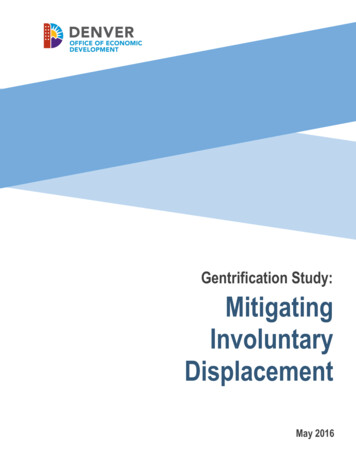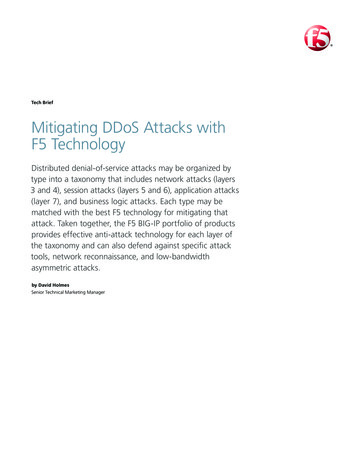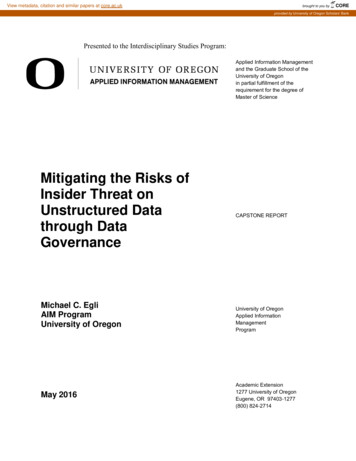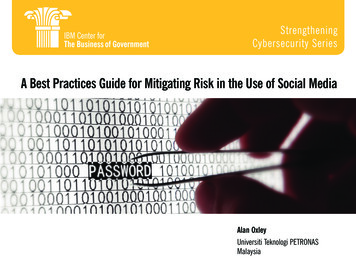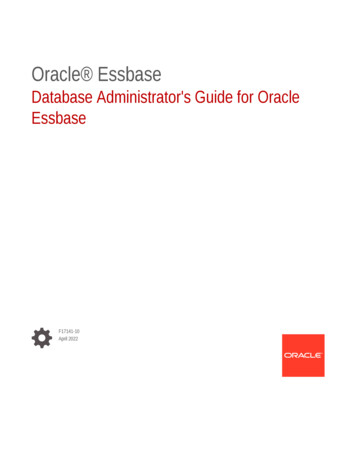
Transcription
PRACTICE ADVISORY1Understanding and Mitigating the Effect of Suspended SentencesBy Al-Amyn Sumar2June 5, 2013This practice advisory discusses the immigration consequences of suspendedsentences. The advisory provides background about the governing statutory frameworkand case law, and suggests strategies for softening the potential impact of suspendedsentences.I. BackgroundTo suspend a sentence is to withhold all or some of a defendant’s punishment.However, depending upon the length of the sentence and the nature of the offense, asuspended sentence can — just like other criminal sentences — carry immigrationconsequences. Under 8 U.S.C. § 1101(a)(43)(F), for example, an aggravated felony isdefined as “a crime of violence . . . for which the term of imprisonment [is] at least oneyear.” Thus, a suspended sentence of one year or more could result in an aggravatedfelony determination and subsequent deportation.8 U.S.C. § 1101(a)(48)(B) explains the immigration consequences of a suspendedsentence. It provides that: “Any reference to a term of imprisonment or a sentence withrespect to an offense is deemed to include the period of incarceration or confinementordered by a court of law regardless of any suspension of the imposition or execution ofthat imprisonment or sentence in whole or in part.” The statute, however, does not definewhat constitutes suspending the imposition of a sentence and suspending a sentence’sexecution, and states do not use those terms uniformly. The Supreme Court in Roberts v.United States, 320 U.S. 264 (1943), explained the distinction between suspension of asentence’s execution and imposition, respectively:In the first instance the defendant would be sentenced in open court toimprisonment for a definite period; in the second, he would be informed inopen court that the imposition of sentence was being postponed. In bothinstances he then would be informed of his release on probation uponconditions fixed by the court. The difference in the alternative methods isplain. Under the first, where execution of sentence is suspended, the1Copyright (c) 2013, National Immigration Project of the National Lawyers Guild. Thisadvisory is not a substitute for independent legal advice and decision-making by a lawyer familiarwith a client’s case. Readers are cautioned to check for new legal developments.2Al-Amyn Sumar is a graduate of Harvard Law School. He authored this advisory under thesupervision of Staff Attorney Sejal Zota and Executive Director Dan Kesselbrenner.1
defendant leaves the court with knowledge that a fixed sentence for a definiteterm of imprisonment hangs over him; under the second, he is made awarethat no definite sentence has been imposed and that if his probation isrevoked the court will at that time fix the term of his imprisonment.Id. at 268.In Roberts, however, the Court was interpreting the Probation Act, not the Immigrationand Nationality Act; the meanings of these terms in the present context is thereforeunclear. For the purposes of this advisory, it is assumed that under 8 U.S.C. §1101(a)(48)(B), a definite term of imprisonment could be (but is not necessarily) attachedto a sentence whose imposition is suspended. It is also assumed that the meaning ofsuspended execution of a sentence within section 1101(a)(48)(B) tracks the definition ofthe term in the Roberts opinion.II. The Board’s Treatment of Imposition and Execution of a SentencePrior to 1996, the immigration statute treated the practices of suspending asentence’s execution and suspending its imposition differently for immigration purposes;however, a 1996 amendment to the INA sought to eliminate the distinction and to treatsuspension of imposition and execution as identical in the immigration context.In a pre-1996 case, Matter of Castro, 19 I. & N. 692 (BIA 1988), the BIAexplained the differing impacts of suspending a sentence’s execution and suspending itsimposition. At issue in Castro was whether the respondent’s conviction fell within thepetty offense exception of the INA; that exception provided that: “An alien who would beexcludable because of the conviction of an offense for which the sentence actuallyimposed did not exceed a term of imprisonment in excess of six months . . . may begranted a visa and admitted to the United States.” Id. at 694 (quoting INA § 212(a)(9)(2006)) (emphasis added). The BIA clarified that “[u]nder the United States criminal lawsystem, courts may either impose a sentence or suspend imposition of the sentence.” Id.If a court chose to do the former, it could then suspend the execution of a sentence. Thedistinction mattered: where the imposition of a sentence is suspended (and probation isoften subsequently granted), no sentence has actually been imposed. However, if theexecution of a sentence is suspended, the BIA continued, “a sentence has actually beenimposed, even though probation may also be granted.” Id.The BIA changed its position after 1996, when an amendment to the INA soughtto erase the difference between the suspension of imposition and execution forimmigration purposes. The amendment, created by section 322(a)(1) of the IllegalImmigration Reform and Immigrant Responsibility Act of 1996 (IIRIRA) and codified at8 U.S.C. § 1101(a)(48)(B), provides that: “Any reference to a term of imprisonment or asentence with respect to an offense is deemed to include the period of incarceration orconfinement ordered by a court of law regardless of any suspension of the imposition or2
execution of that imprisonment or sentence in whole or in part.” The BIA explained theimpact of the amendment in Matter of S-S-, 21 I. & N. Dec. 900 (BIA 1997), in which therespondent challenged the determination that his suspended sentence for an indeterminateterm not to exceed five years rendered him deportable. Citing legislative history,3 theBoard contended that the fact that the respondent’s sentence was suspended “is irrelevantto the analysis, as is the length of time actually served, if any.” Id. at 902. Indeed, thiswould be the case “even if the ‘imposition’ of that sentence was suspended”; the “onlyrelevant inquiry is the term to which respondent was sentenced by the court.” Id.However, the simple language of the statute belies the real complexity of the issue,which emerges from states’ various procedures for suspending sentences. For example,some states require that courts sentence defendants to specific terms of confinementbefore suspending the imposition of a sentence; other states prohibit courts from doing so.As discussed infra, defendants in this latter category of states arguably fall outside thescope of section 1101(a)(48)(B) — if the court does not refer to a specific term ofimprisonment, the requisite “period of incarceration or confinement ordered by a court oflaw” is absent.A more recent BIA case, Matter of Ramirez, 25 I. & N. Dec. 203 (BIA 2010), isalso noteworthy. There, the Board held that where a term of imprisonment is imposed ona defendant after a probation violation, that term is considered part of the penalty for theinitial crime rather than for a separate offense. In the underlying criminal case, aCalifornia trial court suspended the imposition of the sentence on the respondent andgranted 36 months of “summary probation.” Id. at 203–04. There was no specific termof imprisonment attached to the suspended imposition of sentence in the respondent’scase. (This is standard practice in California.)4 Significantly, the Board found that theone-year term of imprisonment requirement associated with the charged aggravatedfelony ground had been satisfied (and that the respondent was therefore an aggravatedfelon) only after his probation violation, which resulted in a one-year sentence —meaning that Ramirez’s original suspended imposition of sentence, in and of itself, didnot qualify as a sentence of imprisonment for immigration purposes.III. Arguments and Strategies3The Board looked to the Joint Explanatory Statement of the Committee of Conference; thatStatement, the BIA explained, indicates that the purpose of section 322(a)(1) of IIRIRA was “tooverturn prior administrative precedent holding that a sentence is not ‘actually imposed’ when thecourt has suspended the ‘imposition’ of the sentence.” S-S-, at 902 (quoting H.R. Conf. Rep. No.104-828).4California prohibits the imposition of a specific term of imprisonment if the imposition of asentence is suspended. Cal. Penal Code § 1170(b) (West).3
A. The absence of a “period of incarceration or confinement ordered by a courtof law”Recall that 8 U.S.C. § 1101(a)(48)(B) provides that a reference to a term ofimprisonment is “deemed to include the period of incarceration or confinement orderedby a court of law.” Two distinct requirements can be discerned from this language: 1)there must be a “period of incarceration or confinement,” and 2) that period must be“ordered by a court of law.”As to the first requirement, there is a powerful argument that, in states wherecourts suspend imposition of sentences without specifying any period of confinement —either because they are prohibited from doing so (like California), or simply because theychoose not to — there is no “period of incarceration or confinement” and therefore nosentence for immigration purposes. These cases are akin to the direct imposition ofprobation on defendants — a practice that is understood to fall outside the purview ofsection 1101(a)(48)(B). See, e.g., United States v. Banda-Zamora, 178 F.3d 728, 730(5th Cir. 1999).Both BIA and federal appeals courts cases lend weight to this view. As notedsupra, the BIA in Matter of Ramirez did not construe the respondent to have a qualifyingsentence under section 1101(a)(48)(B) until after his probation violation; this indicatesthat the trial court’s initial suspension of the imposition of the sentence — which lacked aspecific length — did not come within the statute. Similarly, the Ninth Circuit has foundthat where a court suspends the imposition of sentence and does not specify andpronounce a term of imprisonment, there is no sentence of imprisonment for the purposesof the immigration statute. Vivar-Flores v. Holder, 498 Fed. Appx. 716, 717 (9th Cir.Nov. 20, 2012) (explaining that the factfinder cannot look to a potential sentence thatmay be authorized under the criminal statute, but only to an actual sentence entered, tosatisfy the one-year sentence requirement under 8 U.S.C. § 1101(a)(43)(G)). Though theNinth Circuit remanded to the BIA to determine the proper interpretation in the firstinstance, there is little room for a reading of the statutory language that treats sentenceswithout specific terms of confinement as being within the scope of section1101(a)(48)(B). To be sure, this interpretation of the statute does not negate the effect ofthe 1996 amendment; it simply limits its applicability to instances where specific terms ofconfinement attach to suspended sentences. If in your case the underlying court did notimpose a specific term when suspending the sentence’s imposition, the above argument isavailable to you.The second distinct requirement in section 1101(a)(48)(B) is that the period ofincarceration or confinement must be “ordered by a court of law.” It is significant thatthe statute expressly designates courts, to the exclusion of legislatures, as the entitiesempowered to order the confinement. A basic principle of statutory interpretation is thatstatutes should be construed “so as to avoid rendering superfluous” any statutory4
language, and correspondingly, that courts should not enlarge a statute beyond its text.See, e.g., Astoria Federal Savings & Loan Ass’n v. Solimino, 501 U.S. 104, 112 (1991);Iselin v. United States, 270 U.S. 245, 250 (1926) (Brandeis, J.) (“To supply omissions [toenlarge a statute] transcends the judicial function.”). Applying that principle here, wherea period of incarceration or confinement is not directly ordered by a court — and isinstead, for example, merely authorized by the legislature — the sentence is not subject tothe requirements of section 1101(a)(48)(B).The legislative history indicates that the statute indeed requires an order by acourt of law. The conference committee report that accompanied the 1996 amendmentsand was cited by the BIA in Matter of S-S-, discussed supra, observed that the statutoryamendment “clarifies that in cases where immigration consequences attach dependingupon the length of a term of sentence, any court-ordered sentence is considered to be‘actually imposed,’ including where the court has suspended the imposition of thesentence.” H.R. Conf. Rep. No. 104-828, at 224 (emphasis added). Only sentences thatare court-ordered thus fall within the scope of the statute.Determining whether a court-ordered period of confinement exists requirescareful parsing of the language of a state court’s judgment. For example, the NationalImmigration Project has access to judgments from Georgia courts that order noconfinement. One judgment states, for example, that the defendant is to serve a sentence“consisting of 0 days/months in jail and 24 months on Probation.” The judgment alsoindicates that there is no accompanying suspended sentence. The Georgia Code, however,requires a judge in any case involving a felony or misdemeanor to impose a determinatesentence, all or some of which may be suspended or probated. O.C.G.A. § 17-10-1 (2010).Arguably, every sentence of probation in Georgia requires a suspended or probatedsentence involving a determinate period of confinement. Where the defendant’s statecourt judgment does not suspend the sentence and order confinement and the sentence ofconfinement is instead imposed by statute, this line of reasoning could be of some avail.B. Interpreting “suspension” in section 1101(a)(48)(B)A second line of argument pertains to defendants who are granted probation.United States v. Ayala-Gomez, 255 F.3d 1314 (11th Cir. 2001), held that suspension of asentence occurs where there is a “step intervening between imposition of a prison termand placing a defendant on probation.” Id. at 1318. In that case, the respondent arguedthat his sentence had been “probated” — not “suspended” — and that he therefore felloutside the scope of section 1101(a)(48)(B). The court disagreed, giving no weight to thenames that Georgia attached to its own sentencing mechanisms. Regardless of whatstates call it, the court argued, suspension under section 1101(a)(48)(B) is just the stepbetween imposing the prison term and placing a defendant on probation.5
After Ayala, there are arguably two classes of individuals for whom probation isgranted. First, there are defendants on whom probation is imposed directly (i.e., withoutthe mention of a suspended sentence). As noted earlier, even after Ayala, theseindividuals are not subject to the requirements of section 1101(a)(48)(B). See, e.g.,United States v. Banda-Zamora, 178 F.3d 728, 730 (5th Cir. 1999) (“[W]hen a defendantis directly sentenced to probation, with no mention of suspension of a term ofimprisonment, there has been no suspension of a term of imprisonment.”); United Statesv. Guzman-Bera, 216 F.3d 1019, 1021 (11th Cir. 2000) (same). Second, there aredefendants like Ayala-Gomez, whose sentences are probated indirectly (i.e., after theimposition and suspension of a sentence); in a post-Ayala world, these individuals will besubject to the requirements of section 1101(a)(48)(B). An individual’s membership ineither class hinges on the procedures a state follows in probating the sentences ofdefendants. For the latter group, the most effective argument may simply be that Ayala’sholding is wrong as a legal matter, for the reasons Judge Noonan lays out in his dissent.See Ayala-Gomez, 255 F.3d 1319–21 (Noonan, J., dissenting) (arguing that “suspension”in 1101(a)(48)(B) is defined according to state practice, rather than federal meaning).Judge Noonan’s invocation of the rule of lenity — which requires an ambiguous statuteto be interpreted in favor of defendants — may supply an especially powerful argument.See, e.g., Moncrieffe v. Holder, U.S. , 133 S. Ct. 1678, 1693 (2013); Leocal v.Ashcroft, 543 U.S. 1, 11 n.8 (2004); Lok v. INS, 548 F.2d 37, 39 (2d Cir. 1977) (noting“the settled doctrine that deportation statutes, if ambiguous, must be construed in favor ofthe alien”).Further, if you reside in a state where a court can choose to grant either “direct” or“indirect” probation, you should opt for the former. Texas, for example, has two distinctmechanisms for granting probation. Under the first, the trial court “assesses” punishment,but does not “impose” punishment unless probation is revoked. In effect, a defendantreceives a term of imprisonment, but the sentence is then suspended and probation isimposed. Tex. C.C.P. Art. 42.12 § 2.2(A). Under the second method, a term ofimprisonment is neither assessed nor imposed; proceedings are deferred without anadjudication of guilt, and straight probation is imposed. Id. at § 2.2(B); see also UnitedStates v. Vasquez-Balandran, 76 F.3d 648, 650 (5th Cir. 1996) (interpreting federalsentencing statute).5 If eligible for probation, therefore, defendants in Texas should seekdeferred adjudication of their sentence.5The court in Vasquez-Balandran held that the defendant received a suspended sentence and wastherefore an aggravated felon. In its opinion, the court reproduced the relevant parts of the statecourt judgment:It is therefore considered and adjudged by the Court that the said Defendant isguilty of the offense of Robbery, Count 2 paragraph “B” as confessed by him insaid plea of guilty herein made, and that he be punished by confinement . . . forten (10) years and a fine of 0 . . . The imposition of the above sentence (and6
C. The BIA’s interpretation of section 1101(a)(48)(B) is arbitrary and capriciousInsofar as the BIA is arguing that the statute applies to defendants in states wherecourts cannot grant probation directly (i.e., they must grant probation “indirectly” by firstsuspending the imposition of a sentence), one may argue that such an interpretation is“arbitrary or capricious in substance.” Mayo Foundation for Medical Education andResearch v. United States, 131 S. Ct. 704, 711 (2011). In Judulang v. Holder, 132 S. Ct.476 (2011), the Supreme Court held that the BIA’s policy of hinging an alien’s eligibilityfor discretionary relief on factors “irrelevant to the alien’s fitness to reside in this country”ran afoul of this principle.6 Id. at 484. The BIA, the Court explained “failed to exerciseits discretion in a reasoned manner.” Id.Here, similarly, the BIA’s interpretation of section 1101(a)(48)(B) is not based onreasoned distinctions and hinges an alien’s deportability on a factor wholly irrelevant toher fitness to remain in the country — to wit, whether she resides in a state where a courthas the ability to grant her probation directly. Indeed, at least one federal court has hintedthat the availability of a mechanism for granting probation directly may be relevant to acourt’s analysis. See United States v. Vasquez-Balandran, 76 F.3d 648, 650 (5th Cir.1996) (“Contrary to [the respondent]'s assertion, Texas did (and still does) have aprovision that allowed a defendant to be placed on probation (now ‘communitysupervision’) without first assessing a term of imprisonment.”). Confining the reach ofsection 1101(a)(48)(B) to states where there exists a possibility of placing a defendant onprobation directly is both reasonable and consistent with the Court’s administrative lawjurisprudence.D. Modification of a sentenceIn Matter of Cota-Vargas, 23 I. & N. Dec. 849 (BIA 2005), the Board terminatedremoval proceedings against the respondent, whose sentence was reduced by a state courtfine) is suspended and the Defendant is placed on adult probation under the termsand conditions set out in Exhibit “A” hereto attached.Vasquez-Balandran, 76 F.3d at 649. However, in United States v. Herrera-Solorzano,114 F.3d 48 (5th Cir. 1997), the court found that “an almost identical” state courtjudgment did not fulfill the aggravated felony requirement because it “contain[ed] areference to adult probation next to the term of confinement, . . . suggest[ing] that thestate court may have been directly sentencing [the defendant] to ten years of adultprobation.” Id. at 50. The precise words used in a trial court’s judgment are thus critical.While what is at issue here, unlike in Judulang, is an agency’s interpretation of a statute, ratherthan agency action, the “arbitrary or capricious” analysis is the same. Judulang, 132 S. Ct. at 483n.7.67
from 365 to 240 days. The respondent argued that this new sentence meant that he wasno longer an aggravated felon under 8 U.S.C. § 1101(a)(43)(G). The BIA agreed,holding that where a defendant’s sentence is modified or reduced, the new sentence isvalid for immigration purposes notwithstanding the basis for the reduction. Thus, onestrategy to mitigate the harshness of a suspended sentence is to persuade judges to reducesentences that would otherwise result in adverse immigration consequences.8
This practice advisory discusses the immigration consequences of suspended sentences. The advisory provides background about the governing statutory framework and case law, and suggests strategies for softening the potential impact of suspended sentences. I. Background To suspend a sentence is to withhold all or some of a defendant's punishment.



